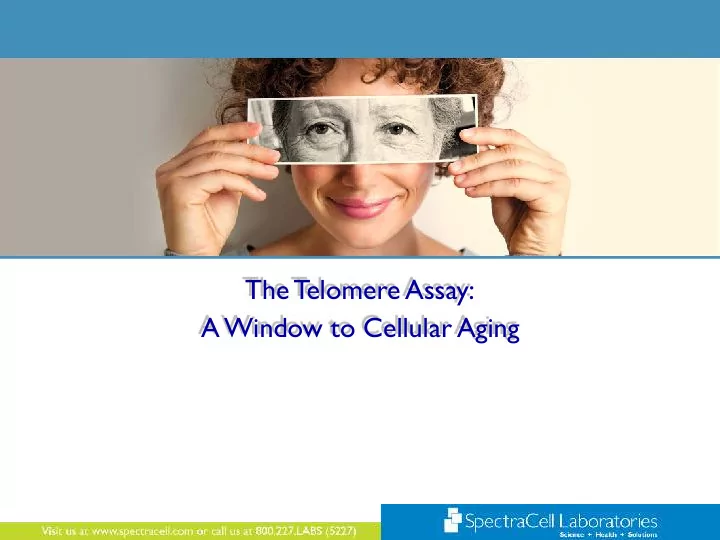

The Telomere Assay: A Window to Cellular Aging
Featured on NBC
Telomere Research 2009 Nobel Prize in Physiology or Medicine awarded for the discovery of “how chromosomes are protected by telomeres and they enzyme telomerase” � 3
What are Telomeres? • Telomeres are… – Repetitive DNA sequences at the ends of all human chromosomes. – They contain thousands of repeats of the six-nucleotide sequence, TTAGGG. – In every human cell there are 23 pairs of chromosomes and thus 92 telomeres (one at each end of 46 total chromosomes) in every cell.
What Do Telomeres Do? • Telomeres protect and separate the chromosomes, similar to the way the plastic on the ends of our shoelaces "caps" and protects the shoelaces from unraveling. • Every time a cell divides, the telomere get a little bit shorter. When the telomeres reach a critical size (~3 kb), the cells stop dividing. • In this way telomeres act as both a cellular clock, and a brake on uncontrolled cell division (cancer).
Telomeres provide a means for "counting" cell division, because they shorten with each cycle Telomeres shorten from 10-15 kb (germ line) to 3-5 kb after 50-60 doublings Telomere Length (humans) 20 (average lengths of TRFs) Cellular senescence is triggered when cells acquire one or a few Normal critically short telomeres. Somatic 10 Cells (Telomerase Negative) Cellular (Replicative) Senescence Number of Cell Divisions
Telomeres & Aging • It is believed that shortened telomeres in mitotic (dividing) cells may be responsible for some of the changes we associate with normal aging. • Because there is very little telomerase in somatic tissues, older people have shorter telomeres particularly in actively regenerating tissues such as skin and intestinal ephithelia. • It is also thought that the telomere shortening mechanistically prevents uncontrolled cell division (e.g., cancer).
Factors Linked to Telomere Shortening • Clinical findings linked to shortened telomeres – Oxidized LDL – Smoking – Obesity – Nutrient deficiencies – Sleep deprivation, poor quality sleep – Lack of estrogen – Lack of testosterone – Lack of human growth hormone – Increased homocysteine – Diabetes/ insulin resistance – Oxidative stress
Meet My Patient – “Bob” • 51 year old male • Triathlete • Stressful job (Litigation Attorney) • Generally follows good diet • Slim (good BMI) • Executive physical results – Cholesterol 210, Triglycerides <100 – CBC, chemistry, EKG = all normal – Told he is healthy, return in one year… � 12
“Bob’s” Below Average Telomere Score Telomere Test Results 12.00 9.00 Telomere Length 6.00 3.00 0.00 0 23 45 68 90 Age(Years) Patient Telomere Score = 5.19 Percentile = 7% • A patient’s telomere score is compared to the average telomere score for each age group within a random sample population.
Above Average Telomere Score 10 7.5 Telomere Score Average 5 2.5 0 0 < 20 20-29 30-39 40-49 50-59 60-69 70-79 >80 Age •Male in his late forties •Patient Telomere Score: 9.34 •Percentile: 96 •The above graph depicts the patient’s telomere score compared to the average telomere score for each age group within a random sample population of approximately 800 individuals. •A patient telomere score below the line (red box) represents a below average telomere score, and a patient score above the line (green box) represents an above average telomere score. If the patient’s age was not provided, a horizontal line representing the patient’s telomere score across all age groups will be shown.
What do I do with the results? • Good telomere score, good lifestyle – Affirmation that what they are doing is working • Poor telomere score, bad lifestyle – Impetus to make serious changes – Evidence of internal aging before external disease • Poor telomere score, good lifestyle – Take a closer look at lifestyle – Quality of food they eat, excessive exercise, stress… – Look further into diagnostics – Subclinical nutritional deficiencies – Antioxidant & inflammatory status – Food sensitivities – Consider hormone replacement therapy � 15
Modifiable Risk Factors •Strengthen immune function •Optimize methylation metabolism •Limit inflammatory processes •Improve mitochondrial function •Reduce (manage) chronic stress •Regulation of glycemic control & insulin function •Correct nutritional deficiencies
What Do I Do with Results? •Look further at available diagnostic tools •Food allergy (sensitivity) testing •Allergy testing is skin prick testing for anaphylaxis (IgE) •Sensitivity testing looks at delayed antibody reactions to food (IgG or IgA) •Hormone testing •Gut function and flora •Omega 3 Index •DHA and EPA levels •Omega 6: omega 3 ratio •Correct nutritional deficiencies!!
Recommend
More recommend